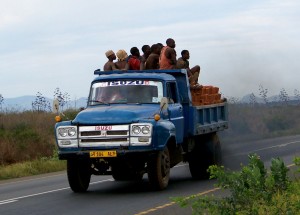 Economics research on the impacts of forced migration is still in the early stages. In a 2003 paper the (non-economist) authors state that they present ‘the kind of academic abstraction that currently characterises much recent scholarship in political science, sociology, and anthropology (economics might be a candidate too, but almost no economics research has been published in refugee studies)’ (full references available in a working paper). An MIT workshop in 2005 on the economics of forced migration drew similar conclusions; ‘despite the recent flourish of interest in international migration, forced migration remains relatively neglected by economists.’
Economics research on the impacts of forced migration is still in the early stages. In a 2003 paper the (non-economist) authors state that they present ‘the kind of academic abstraction that currently characterises much recent scholarship in political science, sociology, and anthropology (economics might be a candidate too, but almost no economics research has been published in refugee studies)’ (full references available in a working paper). An MIT workshop in 2005 on the economics of forced migration drew similar conclusions; ‘despite the recent flourish of interest in international migration, forced migration remains relatively neglected by economists.’
It is true that in the early 2000s there was almost no economics research on forced migration, but since then the situation has changed and although the literature is still not abundant, there is enough now to make it possible and potentially very useful to systematically analyse it. That is the purpose of one of my recent articles (co-authored with Isabel Ruiz from Harris-Manchester College at Oxford, forthcoming in the Journal of Development Studies, currently available as a working paper), to provide an assessment of the economics evidence on the impacts of forced migration.
The article limits its analysis to the impacts of violence-induced forced migration and internal displacement or refugee movements into neighbouring countries. In this context it is relevant to ask: impacts on whom? There are many stakeholders which could be affected by forced migration. We divided the impacts into two categories: (i) the impacts of forced migration on the forced migrants themselves and (ii) the impacts of forced migration on host communities. While it is not possible to cover all those potentially affected using this typology, this division does encapsulate the groups covered by the existing economics research (the impact of forced migration on the communities of origin was also considered but the economics research on this topic is practically nonexistent). The discussion below provides some key points on the first of those areas: the impacts of forced migration on forced migrants.
The long-term perspective
When discussing forced migration the first thing which comes to mind for many is the result of civil wars in the African continent or violence in the Middle East. However, a considerable portion of the economics research on forced migration impacts looks at the impact of European forced migration movements resulting from events related to WWII. These studies provide a particularly interesting perspective as it is possible to observe the long-term consequences of forced migration.
Several studies explore specific events, such as displacement that resulted after Finland ceded a portion of its territory to the Soviet Union following WWII and the consequences of forcing millions of “ethnic” Germans to migrate and settle within the new borders of West Germany. It may come as a surprise to many to know that results from these studies often suggest that displacement increased the long-term income of the displaced! Why? In part this is due to successful resettlement policies and in part to increase mobility of those who were displaced (e.g. less local attachments and higher disposition to change locations to get a better job). Moreover, those forced migrants who were employed in the agricultural sector before WWII experienced a faster transition to other sectors, which increased their long-term income relative to stayers.
Developing countries
The economics research on long-term impacts of forced migration is concentrated on European countries. The literature for developing countries, which is focused on short- and medium-term impacts, suggest that there are severe consequences of forced migration. The key studies conducted in developing countries have concentrated on a few forced migration situations, namely: internal displacement in Colombia, internal displacement in Northern Uganda, internal displacement in Sudan and the refugee inflow from Burundi and Rwanda to Tanzania.
Selected findings from existing economics research in developing countries include:
- Agricultural productivity: Contrary to the European context discussed above, in developing countries it is often not possible for forced migrants to make a transition from the agricultural sector to other sectors of employment. That is, forced migrants depend on the agricultural sector in both, the “pre” and “post” forced migration stages. In many cases displacement is detrimental for agricultural productivity. Some reasons for this include: the periods spent in displacement may erode agricultural skills, there are fewer transfers of agricultural skills to the next generation and agricultural skills may not be transferable to the new place of residence (for example, different soil, elevation and topography). However, in other situations displaced individuals “resettle” in the more agriculturally productive areas and experience increased agricultural productivity.
- Consumption smoothing: Standard economic theory suggests that consumption should depend only on permanent income and should not respond to (predictable!) transitory income variations. That is, individuals and households should transfer resources across periods in order to smooth consumption over time. Forced migration seems to affect the typical mechanisms used for consumption smoothing such as selling assets, using savings, accessing formal or informal credit markets and formal or informal risk-sharing mechanisms. Therefore, in many situations forced migrants are unable to smooth consumption.
- Camps: Ceteris Paribus, the length of time that a refugee camp has been in existence has implications for the economic outcomes of camp residents, even for recent refugee arrivals. In many camps a ‘culture of idleness’ develops over time (especially for males). The evidence suggests that it takes time for the ‘culture of idleness’ to develop, as it typically involves factors such as a market for booze, establishments for drinking and other venues for passing time such as places for watching sports. However, the literature also suggests that poor conditions in return locations often offset the benefits of camp decongestion.
 Forced migration situations provide an excellent opportunity for economists to explore many subjects related to the impacts of migration which are not easily explored under ‘voluntary’ migration situations. Issues related to the role of unobserved characteristics, location selection and self-selection into migration, among others, are often less important in forced migration situations. Economists seem to be slowly realising the opportunities for research provided by forced migration situations and a literature on the ‘economics of forced migration’ has emerged during the last decade. The policy-making sector is also realising the importance of having a clear understanding of the economic implications of displacement. Determining the economic impacts of forced migration is essential in order to identify policies which can minimise the negative impacts of forced migration, and optimise the economic opportunities arising from such contexts. A new project from the World Bank in conjunction with the Refugee Studies Centre developed a methodology to estimate the economic impact of forced migration situations. The current combination of academic and policy interest in the economics of forced migration suggest that next five years will bring exciting new insights on the topic.
Forced migration situations provide an excellent opportunity for economists to explore many subjects related to the impacts of migration which are not easily explored under ‘voluntary’ migration situations. Issues related to the role of unobserved characteristics, location selection and self-selection into migration, among others, are often less important in forced migration situations. Economists seem to be slowly realising the opportunities for research provided by forced migration situations and a literature on the ‘economics of forced migration’ has emerged during the last decade. The policy-making sector is also realising the importance of having a clear understanding of the economic implications of displacement. Determining the economic impacts of forced migration is essential in order to identify policies which can minimise the negative impacts of forced migration, and optimise the economic opportunities arising from such contexts. A new project from the World Bank in conjunction with the Refugee Studies Centre developed a methodology to estimate the economic impact of forced migration situations. The current combination of academic and policy interest in the economics of forced migration suggest that next five years will bring exciting new insights on the topic.
For further information on the points I raise and the research that is covered here please look at the following references:
Florence Kondylis (Rwanda, Bosnia and Herzegovina)
Jennifer Alix-Garcia (Darfur, Tanzania)
The Economics of Forced Migration (co-authored with Isabel Ruiz, forthcoming in JDS)